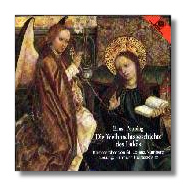
The Internet's Premier Classical Music Source
Related Links
- Latest Reviews
- More Reviews
-
By Composer
-
Collections
DVD & Blu-ray
Books
Concert Reviews
Articles/Interviews
Software
Audio
Search Amazon
Recommended Links
Site News
 CD Review
CD Review
Ernst Pepping

The Christmas Story According to Luke
- Ernst Pepping: Die Weihnachtsgeschichte des Lukas
- Olivier Messiaen: Verset pour la Fete de la Dedicace
- Max Reger: Te Deum from 12 Pieces for organ, Op. 59
Hermann Harrassowitz, organ
Kammerchor von St. Lorenz, Nürnberg/Hermann Harrassowitz
Motette CD 50641
Max Reger in his brief life nevertheless, I believe, started many things – among others, a modern German school of choral writing. Pieces like the Op. 110 Motets, the choral cantatas, and the 8 Sacred Songs influenced Hindemith, among others. Indeed, I believe Hindemith edited one of these works. Hindemith's harmonic language and contrapuntal aesthetic influenced a slightly later set of composers: Hugo Distler, Ernst Pepping, Johann Nepomuk David, and Rudolf Mauersberger. However, where Hindemith and Reger looked primarily to Bach as the model of sacred choral writing, the others went farther back to Schütz, particularly works like the Weihnachtshistorie (Christmas Story), the Musikalisches Exequien, and the Kleine geistliche Konzerte (Little Sacred Concertos). Distler, probably the greatest of this group, died young, a suicide. David and Mauersberger aren't all that well known outside of Germany and Austria.
Pepping is probably best known outside Germany for his Te Deum (1956), which appeared on an old DGG LP in the early 60s, and other choral music, although he has written in every musical genre except opera. Somewhere at some time, there have been recordings of his 3 symphonies, and if you see these, pounce. The work I know shows a highly complex musical intellect with a ferocious gift for organizing and planning large works. Sounds like a symphonist to me.
Die Weihnachtsgeschichte des Lukas (the Christmas story according to Luke, 1959) divides into seven sections: Introduction, The Annunciation of the Birth, Maria and Elisabeth, The Birth, The Angel, The Shepherds, and a Conclusion. The texts come not only from the Gospel of Luke, but, as has been traditional at least since Schütz, from folk sources as well. The harmony, as I said, derives from Hindemith, with, however, even greater contrapuntal complexity than one finds in Hindemith's choral music. Pepping weaves plainchant and chorales into the texture throughout – I've spotted Es ist ein Ros' entsprungen (Lo, how a rose e'er blooming), Hodie Christus natus est, and Virga Jesse floruit so far. I'll probably find more sooner or later.
The work's 40-minute length alone taxes a choir. The writing is mostly in 4 parts and, at one point, increases to 7. Again, the writing is fairly dense. Furthermore, Pepping sets key phrases to the same musical gesture throughout. For example, in the passage
It happened at that time, that a decree went out from Caesar Augustus, that all the world should be taxed. And this taxing first occurred when Cyrenius was governor in Syria. And every man went to be taxed, each to his own city. Then Joseph went from Galilee from the city of Nazareth in the land of Judea to the city of David, called Bethlehem, so that he would be taxed, with Mary, his wife, who was pregnant.
Note how the word "taxed" (in German, schatzen) binds that text together. Pepping binds the passage musically by setting each occurrence of that word or its derivatives to the same notes. This technique also occurs in his earlier Te Deum. Thus, we have both a horizontal complexity of melodic motives and a vertical complexity of contrapuntal strands alluding to other Christmas traditions and contexts.
The work has a prayer only with a choir with stamina and smarts. The St. Lorenz chamber choir falls short on both counts. They produce a tone that sounds like a tire losing air. Intonation, especially the basses (in other words, the foundation of the harmony), is always dicey. Major chords sound like augmented ones. None of the voices – sopranos, altos, tenors, or basses – can sing even in unison (good stretches of this work are unison). You hear a constant spread. Thus, the texture never clarifies enough to hear the contrapuntal commentary, and the general vocal fatigue tends to lose the narrative coherence of each section. It's like listening to a monotone drawler recite the Bible. A recording as weak as this does the composer a terrific disservice, since most people will blame their boredom on the work.
The Reger is (for him) a bon-bon on the Te Deum chant. Its brevity recommends it. The Messiaen, far more substantial, makes use of chant, rhythmically free bird song, and chorale. Like much work by this composer, the highly chromatic alternates with simple diatonicism. I had not heard this particular piece before, and, from what I gather in the German liner notes, it occurs in the middle of a long dry spell of no organ music in Messiaen's output – between the Livre d'Organ (1951) and the Meditations sur le Mystere de la Sainte Trinite (1969). Messiaen is, of course, a major composer for the instrument. It's probably against degree requirements for an organ scholar not to program a Messiaen work in the senior recital. The piece jumps between serenity and anxiety. It appeals to me. I will certainly listen to it again. But this is only 8 minutes on a disc, and there are probably other performances.
Copyright © 1996, Steve Schwartz


















